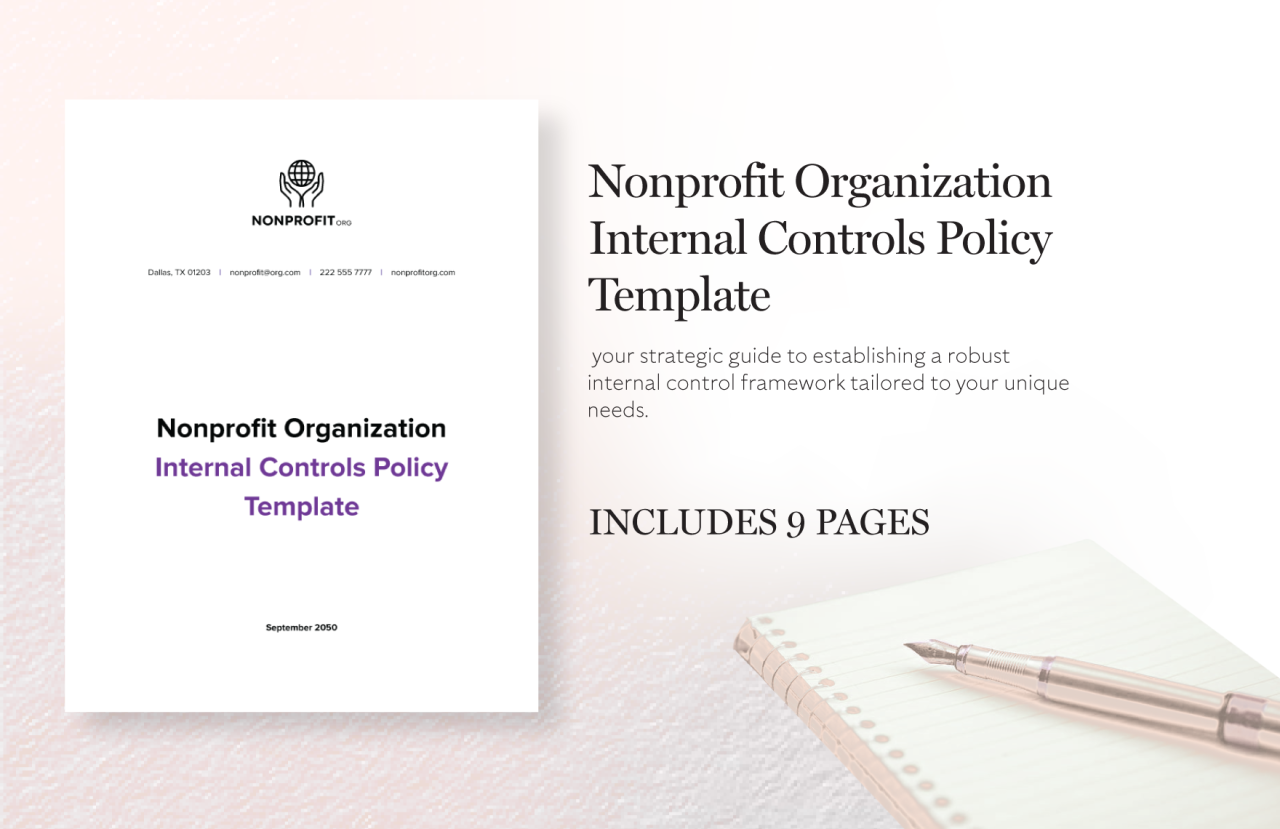
Internal Controls at Small Businesses & Nonprofits A Guide
Internal controls at small businesses not for profits are crucial for safeguarding assets, ensuring accuracy in financial reporting, and mitigating risks. This guide explores the complexities of implementing and maintaining robust internal controls tailored to the unique needs of these organizations. We’ll delve into the specific challenges, practical steps, and best practices for achieving effective control systems.
From preventative measures to technological enhancements, we’ll cover a range of topics, including different types of controls, implementation strategies, and the importance of ongoing evaluation. This comprehensive overview will equip you with the knowledge necessary to build and maintain a strong internal control framework within your organization.
Introduction to Internal Controls at Small Businesses and Nonprofits
Internal controls are crucial for the smooth and ethical operation of any organization, regardless of its size or mission. They provide a framework for ensuring accuracy in financial reporting, safeguarding assets, and promoting compliance with relevant regulations. Small businesses and nonprofits, often with limited resources and expertise, face unique challenges in implementing and maintaining robust internal controls. However, effective controls are essential for their long-term sustainability and success.Implementing strong internal controls minimizes risks associated with fraud, errors, and operational inefficiencies.
This structured approach also builds trust with stakeholders, investors, and donors, ultimately contributing to the organization’s reputation and financial health.
Overview of Internal Controls
Internal controls are a system of policies and procedures designed to safeguard assets, ensure accuracy and completeness of financial records, promote operational efficiency, and adhere to relevant laws and regulations. They encompass a range of activities, from authorizing transactions to safeguarding assets and ensuring compliance.
Key Components of Internal Controls
Internal controls are comprised of several interconnected components, each playing a vital role in the overall system. Understanding these components is essential for developing a comprehensive internal control framework.
- Authorization: Establishing clear procedures for authorizing transactions ensures that only valid and authorized activities are processed. For example, a company policy might require a manager’s signature for purchases exceeding a certain amount.
- Recording: Accurate and timely recording of transactions is essential for maintaining an accurate financial picture. This includes proper documentation of all financial activities and ensuring that all transactions are recorded in the correct accounts.
- Safeguarding: Protecting assets from theft, loss, or damage is a critical component of internal controls. This can include physical security measures, such as locks and alarms, and procedures for managing inventory and cash.
- Compliance: Adhering to all applicable laws, regulations, and internal policies is crucial for minimizing risks and maintaining a strong reputation. Nonprofits, in particular, must adhere to specific regulations related to fundraising and financial reporting.
Challenges for Small Businesses and Nonprofits
Implementing robust internal controls can present unique challenges for small businesses and nonprofits due to limited resources, staff expertise, and organizational structure.
- Resource Constraints: Limited budgets and staff often restrict the ability to hire specialized personnel or invest in sophisticated control systems.
- Expertise Gaps: Small organizations may lack the expertise to design and implement effective internal controls, leading to gaps in the system.
- Organizational Structure: The decentralized structure of some small businesses can make it challenging to enforce consistent control procedures across the organization.
Internal Controls for Profit vs. Nonprofit Organizations
While the fundamental principles of internal controls remain consistent, there are key differences in the implementation and application for profit and nonprofit organizations.
| Characteristic | For-Profit Organizations | Nonprofit Organizations |
|---|---|---|
| Primary Goal | Maximizing shareholder value | Serving a specific mission |
| Funding Sources | Revenue from sales and investments | Donations, grants, and program fees |
| Reporting Requirements | Typically governed by generally accepted accounting principles (GAAP) | Often governed by specific regulatory frameworks, including IRS guidelines |
Consequences of Inadequate Internal Controls, Internal controls at small businesses not for profits
Failure to implement or maintain adequate internal controls can have severe consequences for small businesses and nonprofits.
- Financial Losses: Inadequate controls can lead to theft, fraud, and errors, resulting in significant financial losses.
- Reputational Damage: A lack of controls can erode public trust and damage the organization’s reputation, impacting fundraising and partnerships.
- Legal Issues: Noncompliance with regulations can result in legal penalties and fines.
- Operational Inefficiencies: Ineffective controls can lead to delays, errors, and inefficiencies in daily operations.
Types of Internal Controls for Small Businesses and Nonprofits
Small businesses and nonprofits often operate with limited resources and staff. Effective internal controls are crucial for safeguarding assets, ensuring accuracy in financial reporting, and promoting operational efficiency. Implementing a robust system of internal controls is a vital step toward minimizing risks and promoting trust among stakeholders.Internal controls are a multifaceted system designed to mitigate risks and enhance the reliability of financial reporting.
They encompass a range of procedures and policies implemented across different functional areas. These procedures are categorized based on their function, allowing for a more structured and efficient approach to risk management. A well-defined system of internal controls significantly reduces the chances of fraud and errors, ultimately benefiting the organization.
Preventative Internal Controls
Preventative controls are designed to stop problems before they occur. These controls focus on establishing procedures that deter errors and fraud. They often involve establishing clear policies and procedures, proper training, and robust documentation.
- Separation of Duties: Dividing responsibilities for tasks such as receiving cash, recording transactions, and authorizing payments. This prevents one person from having complete control over a process, minimizing the opportunity for fraud. For instance, a cashier shouldn’t also be responsible for reconciling the bank statements.
- Strong Password Policies: Implementing strict password requirements for accessing sensitive data and systems, like financial records. This ensures unauthorized access is minimized. This can be as simple as enforcing password complexity requirements and regular password changes.
- Physical Security Measures: Implementing safeguards to protect physical assets, such as locking up cash drawers, securing inventory, and using access control systems. This prevents theft and unauthorized access. For example, using security cameras in the warehouse or restricting access to sensitive areas.
Detective Internal Controls
Detective controls are designed to identify errors or fraud after they occur. These controls often involve regular monitoring and reviews.
- Reconciliations: Regularly reconciling bank statements with accounting records to detect discrepancies. This helps identify errors or fraudulent activity in a timely manner. For example, comparing the cash balance per bank statement to the cash balance in the accounting system.
- Regular Audits: Conducting regular internal or external audits to assess the effectiveness of internal controls and identify potential weaknesses. This involves evaluating the procedures and policies to ensure their efficacy.
- Performance Reviews: Implementing regular performance reviews for employees to assess their adherence to established policies and procedures. This helps catch deviations early. An example would be evaluating the processing of invoices to ensure compliance with company procedures.
Corrective Internal Controls
Corrective controls are put in place to correct errors or fraud that have already occurred. They involve procedures for resolving issues promptly and efficiently.
- Reconciliation Procedures: Procedures for resolving discrepancies identified through reconciliations, such as investigating and correcting errors in transactions. This involves steps to correct the error, such as issuing corrected invoices or adjusting bank reconciliations.
- Corrective Action Plans: Creating and implementing corrective action plans to address identified weaknesses in internal controls. These plans specify the steps required to strengthen the controls and prevent future occurrences.
- Training and Retraining: Providing training and retraining for employees to address identified deficiencies and improve their understanding of internal controls. For example, retraining staff on proper cash handling procedures following an internal audit that highlighted deficiencies in this area.
Segregation of Duties
Segregation of duties is a critical component of internal controls. It involves dividing responsibilities for tasks so that no single person has complete control over a process. This is a key preventative measure to mitigate the risk of fraud and error.
- Importance in Small Businesses and Nonprofits: In smaller organizations, it might seem challenging to implement full segregation of duties. However, even partial segregation of duties can be highly effective in preventing fraud. A key is identifying critical functions and assigning them to different individuals.
- Examples in Functional Areas: In cash handling, separate individuals should be responsible for receiving cash, recording cash receipts, and reconciling bank statements. In accounts receivable, different individuals should be responsible for sending invoices, collecting payments, and recording payments received.
Preventing Fraud and Embezzlement
A strong internal control system acts as a formidable barrier against fraud and embezzlement. By implementing clear policies and procedures, separating duties, and implementing monitoring mechanisms, organizations can significantly reduce the opportunities for fraudulent activities.
- Mitigating Risk: Robust internal controls minimize the opportunities for fraud by making it more difficult for individuals to commit fraudulent acts. Clear policies and procedures make it clear what actions are acceptable and which are not.
- Early Detection: Detective controls help identify fraudulent activities or errors as they occur. This allows for prompt action and mitigation of the impact. Reconciliations and regular audits are key components in detecting potential problems.
Implementing Internal Controls at Small Businesses and Nonprofits
Small businesses and nonprofits often face unique challenges in establishing and maintaining effective internal controls. These organizations frequently have limited resources and personnel, which necessitates a pragmatic and adaptable approach to implementing controls. This section will Artikel a step-by-step process for implementing internal controls, highlighting crucial aspects for these types of organizations.Implementing strong internal controls is not a one-time event but rather a continuous process of improvement.
This involves identifying weaknesses, developing corrective measures, and continually monitoring their effectiveness. A well-structured implementation plan, tailored to the specific needs and resources of the organization, is crucial for success.
Step-by-Step Process for Implementing Internal Controls
A systematic approach to implementing internal controls ensures a comprehensive and effective process. This process involves several steps:
- Assessment and Identification: Begin by assessing the current internal control environment. Identify existing processes and document their strengths and weaknesses. This involves a thorough review of all operational areas, including financial transactions, inventory management, and personnel procedures. This initial step helps determine where control gaps exist.
- Control Design and Documentation: Develop specific internal controls to address identified weaknesses. These controls should be tailored to the organization’s size, structure, and operational activities. Clearly document each control, including the responsibilities assigned to specific individuals. Documentation ensures everyone understands their roles and responsibilities.
- Implementation and Training: Put the designed controls into practice. Ensure all employees understand their roles and responsibilities related to the new controls. Conduct training sessions to clarify expectations and demonstrate the procedures. Clear communication and training are essential for successful implementation.
- Testing and Evaluation: Regularly test the effectiveness of the implemented controls. This might involve simulations or spot-checks to verify that the controls are functioning as intended. Use the results to identify areas needing adjustments or improvements. Continuous testing ensures controls remain relevant and effective.
- Monitoring and Review: Establish a system for monitoring and reviewing the internal control environment. This includes regular reviews of control procedures and feedback mechanisms to identify potential issues. This ongoing monitoring is crucial for adapting to changing circumstances and maintaining control effectiveness.
Comparison of Implementation Methods for Internal Control Types
Different types of internal controls require different implementation approaches. A structured comparison aids in selecting the most appropriate method.
| Internal Control Type | Implementation Method | Example |
|---|---|---|
| Preventive Controls | Establish policies and procedures to prevent errors or fraud from occurring in the first place. | Segregating duties, using pre-numbered documents, requiring authorization for transactions. |
| Detective Controls | Implement methods to detect errors or fraud after they occur. | Reconciliations, periodic audits, reviewing transaction logs. |
| Corrective Controls | Develop procedures to correct errors or fraud when they are detected. | Procedures for correcting errors in accounting records, handling customer complaints, investigating fraud. |
Policies and Procedures Supporting Internal Control Implementation
Clear policies and procedures provide a framework for implementing and maintaining internal controls. The following examples demonstrate this:
- Segregation of Duties Policy: Defines responsibilities for different tasks to prevent any single person from controlling a process from start to finish. This prevents fraud by minimizing the opportunity for collusion.
- Expense Report Policy: Artikels the procedures for submitting, approving, and processing expense reports. This ensures proper documentation and authorization for all expenses.
- Inventory Management Policy: Specifies the procedures for receiving, storing, and issuing inventory. This policy minimizes theft and ensures accurate inventory records.
- Payroll Policy: Describes the procedures for calculating, approving, and distributing employee paychecks. This ensures accurate and timely payment of wages.
Resources and Tools for Implementation
Several resources and tools can support the implementation process. These tools can assist in automating tasks and improving efficiency:
- Software solutions: Accounting software, inventory management systems, and CRM systems can automate tasks and enhance the accuracy of records.
- Internal control frameworks: Frameworks such as COSO and COBIT provide guidance and best practices for designing and implementing internal controls.
- Consultants: Experienced consultants can provide expert advice and support during the implementation process. This is particularly beneficial for organizations with limited internal resources.
Ongoing Monitoring and Evaluation of Controls
Regular monitoring and evaluation are crucial for maintaining the effectiveness of internal controls. This ensures that controls continue to adapt to the changing needs of the organization.
- Regular reviews: Conduct periodic reviews of the internal control system to identify weaknesses and make necessary adjustments.
- Feedback mechanisms: Establish feedback mechanisms for employees to report any control weaknesses or concerns.
- Management oversight: Management must actively oversee the internal control system to ensure its ongoing effectiveness and relevance.
Technology and Internal Controls at Small Businesses and Nonprofits

Technology is rapidly transforming the landscape of small businesses and nonprofits, offering powerful tools to enhance internal controls. Leveraging these tools can significantly improve efficiency, accuracy, and accountability, mitigating risks and fostering trust among stakeholders. This shift empowers organizations to operate more effectively and sustainably, aligning with best practices in financial management.Implementing robust internal controls is crucial for maintaining financial integrity and transparency in any organization, regardless of size or structure.
Technology provides a dynamic and adaptable approach to strengthen existing procedures and streamline operations. By embracing technology, small businesses and nonprofits can build more resilient and reliable control systems, safeguarding assets and promoting ethical practices.
Enhancing Internal Control Systems with Technology
Technology provides a wide array of tools and platforms that can bolster internal controls. These tools can automate tasks, enhance data security, and provide greater visibility into financial transactions. Effective implementation requires careful planning and consideration of existing workflows.
Examples of Technology-Enhanced Internal Controls
| Technology | Internal Control Enhancement |
|---|---|
| Accounting Software (e.g., QuickBooks, Xero) | Automated data entry, streamlined reporting, improved accuracy in financial statements, facilitating better tracking of transactions, and generating detailed reports for analysis. |
| Cloud-based Solutions | Centralized data storage, enhanced security features, accessibility from various locations, and improved collaboration among team members. |
| Point-of-Sale (POS) Systems | Real-time transaction monitoring, improved inventory management, and automated data collection for sales analysis. |
| Automated Expense Reporting | Reduced manual data entry, improved accuracy, and streamlined expense approval processes, allowing for more efficient use of resources. |
| Fraud Detection Software | Real-time monitoring of transactions, identification of suspicious patterns, and alerting of potential fraud attempts. |
Impact on Segregation of Duties and Transaction Monitoring
Technology significantly impacts segregation of duties and transaction monitoring. Automated systems can enforce predefined rules and restrictions, ensuring that specific tasks are handled by designated personnel. This reduces the risk of errors or fraud by limiting access to critical data and processes. For instance, automated approvals for purchase orders or expense reports can be triggered based on pre-set thresholds or employee roles, streamlining the process while safeguarding against unauthorized access.
Data Security and Privacy
Robust data security and privacy are paramount when integrating technology into internal control systems. Protecting sensitive financial information and maintaining compliance with relevant regulations are critical. Data encryption, multi-factor authentication, and access controls are essential elements to protect against unauthorized access, cyber threats, and data breaches.
Integrating Technology with Existing Procedures
Integrating technology with existing internal control procedures requires a phased approach. Start by identifying areas where technology can improve existing processes. Next, conduct a thorough assessment of the organization’s current procedures to ensure a smooth transition. Finally, train staff on new systems and procedures to maximize efficiency and minimize disruptions. A pilot program with a select group of users can be used to test the new system before implementing it across the entire organization.
This approach ensures a gradual and controlled transition, allowing for adjustments and addressing potential issues proactively.
Internal Control Best Practices for Specific Areas
Implementing robust internal controls is crucial for small businesses and nonprofits to safeguard assets, ensure accuracy in financial reporting, and promote transparency. Effective controls reduce the risk of fraud, errors, and misappropriation of funds, fostering trust among stakeholders and enabling sustainable growth. This section details best practices across key operational areas.Effective internal controls provide a framework for managing risks and ensuring the reliability of financial information.
By adhering to these best practices, organizations can build confidence in their operations and financial reporting, while also mitigating potential financial losses.
Cash Handling Best Practices
Effective cash handling is paramount for any organization. A robust system prevents theft, errors, and ensures accurate financial records. This includes segregation of duties, requiring two people for high-value transactions. Regular bank reconciliations are vital for identifying discrepancies promptly. All cash receipts should be deposited daily and properly documented.
- Segregate duties: Separate the responsibilities of handling cash from recording cash transactions. For instance, one person should handle cash receipts, while another person is responsible for recording those receipts in the accounting system. This prevents any one person from having access to both the cash and the accounting records.
- Implement a dual-signature policy: Require two authorized individuals to handle significant cash transactions. This adds an extra layer of security and accountability.
- Establish a petty cash system: Use a petty cash fund for small, routine expenses, reducing the need to handle large sums of cash frequently.
- Employ pre-numbered receipts: Track cash receipts using pre-numbered receipts, making it easier to account for all transactions and prevent any missing receipts.
- Reconcile bank statements regularly: Compare bank statements to internal records on a regular basis (e.g., monthly or weekly) to identify discrepancies and address them promptly.
Accounts Receivable and Payable Best Practices
Effective management of accounts receivable and payable is essential for maintaining healthy cash flow. Strong internal controls minimize the risk of bad debts and ensure timely payment of obligations.
- Establish clear credit policies: Define credit terms and procedures for extending credit to customers. This will help predict and manage potential losses from uncollectible accounts.
- Implement a system for following up on overdue accounts: Set up a system for regularly monitoring and following up on outstanding invoices to ensure timely payment.
- Automate invoice processing: Use accounting software to automate invoice processing, reducing manual errors and improving efficiency.
- Verify vendor invoices: Thoroughly review vendor invoices before payment to ensure accuracy and compliance with purchase orders.
- Establish payment terms with vendors: Negotiate clear payment terms with vendors to optimize cash flow.
Inventory Management Internal Controls
Effective inventory management controls help organizations maintain accurate records of stock levels, monitor costs, and prevent theft or loss.
- Establish a perpetual inventory system: Maintain a running record of inventory levels, tracking goods received, issued, and on hand.
- Use barcodes or RFID tags: Implement a system for tracking inventory items with barcodes or RFID tags to streamline inventory management and reduce errors.
- Conduct regular physical inventory counts: Periodically count physical inventory to reconcile with records and identify discrepancies.
- Segregate duties for inventory: Separate responsibilities for receiving, storing, and issuing inventory to prevent fraud.
- Implement a system for inventory valuation: Use a standard method for valuing inventory, such as FIFO (First-In, First-Out), to ensure accuracy in financial reporting.
Safeguarding Assets and Protecting Sensitive Data
Protecting assets and sensitive data is crucial for maintaining the integrity and reputation of an organization.
- Implement strong access controls: Restrict access to sensitive data and physical assets to authorized personnel.
- Use encryption for sensitive data: Protect sensitive data using encryption techniques to prevent unauthorized access.
- Secure physical premises: Implement security measures to protect physical assets from theft and damage, such as surveillance cameras and secure storage areas.
- Establish a data backup and recovery plan: Develop a plan for backing up and recovering data in case of system failures or data breaches.
- Comply with relevant regulations: Ensure compliance with data privacy regulations, such as GDPR or CCPA.
Internal Controls Relevant to Financial Reporting
Accurate and reliable financial reporting is essential for making informed decisions and maintaining transparency.
- Establish a chart of accounts: Create a clear and consistent chart of accounts to ensure accurate recording and classification of transactions.
- Implement a system for internal audits: Schedule regular internal audits to evaluate the effectiveness of internal controls and identify areas for improvement.
- Maintain accurate accounting records: Ensure that all transactions are recorded accurately and in a timely manner.
- Employ reconciliation procedures: Implement reconciliation procedures for various accounts (e.g., bank reconciliations, accounts receivable reconciliations) to identify discrepancies.
- Adhere to generally accepted accounting principles (GAAP): Ensure financial reporting adheres to GAAP or the relevant framework.
Evaluating and Improving Internal Controls

Regularly evaluating internal controls is crucial for the long-term health and success of any small business or nonprofit. A robust system of internal controls not only safeguards assets and ensures accuracy in financial reporting but also promotes transparency, accountability, and efficiency. By proactively identifying and addressing weaknesses, organizations can mitigate risks, enhance compliance, and build trust with stakeholders.A thorough evaluation process isn’t a one-time event but rather an ongoing cycle of assessment, improvement, and adaptation.
Understanding the dynamics of your organization and the ever-evolving external environment is key to maintaining effective internal controls.
Identifying Control Deficiencies
Effective internal controls rely on a systematic process of identifying potential weaknesses. This involves a careful examination of existing procedures, policies, and practices. This includes reviewing documentation, interviewing personnel, and observing operational processes. A thorough understanding of the organization’s specific risks is critical to determining the effectiveness of existing controls. The identification process should involve personnel at various levels within the organization to gain diverse perspectives and uncover blind spots.
Implementing Corrective Actions
After identifying control deficiencies, the next crucial step is implementing corrective actions. This involves developing and implementing changes to existing processes, policies, or procedures. Corrective actions should be documented clearly and communicated effectively to all relevant personnel. These changes should be tested thoroughly to ensure their effectiveness and prevent unintended consequences. Consideration should be given to the potential impact of the changes on different parts of the organization.
A phased approach can be beneficial, allowing for adjustments and refinement based on real-world experiences.
Conducting Internal Audits and Reviews
Internal audits are critical for evaluating the effectiveness of internal controls. These audits should be conducted by trained personnel who are independent from the areas being audited. Internal audits can be scheduled on a regular basis or triggered by specific events, such as a change in personnel or a significant operational shift. The audit process should involve a comprehensive review of relevant documentation, procedures, and controls.
The results of these audits should be documented and reported to management for appropriate action. Internal reviews, on the other hand, are often more focused on specific processes or areas of concern, providing more targeted feedback and adjustments.
Examples of Control Deficiencies and Mitigation Strategies
- Lack of Segregation of Duties: One individual handling all aspects of a transaction, from authorization to recording, increases the risk of fraud. Mitigation involves separating duties so that one person cannot manipulate the process. For instance, separate individuals for authorization, recording, and reconciliation of payments.
- Inadequate Authorization Procedures: Lack of clear authorization levels and processes for transactions can lead to unauthorized expenditures or payments. Mitigation involves establishing clear authorization levels, documenting approval procedures, and implementing appropriate access controls. This could include requiring multiple signatures for significant transactions.
- Insufficient Physical Security: Failure to safeguard physical assets can lead to theft or damage. Mitigation includes implementing access controls, security systems, and regular security audits. This could involve installing security cameras, implementing keycard access systems, and conducting regular inventory checks.
Measuring Effectiveness of Internal Controls
Regularly assessing the effectiveness of internal controls is essential. Metrics such as the frequency of errors, the amount of losses due to fraud, and the time taken to complete transactions can be used to evaluate the effectiveness of controls. Monitoring these metrics over time can highlight areas needing improvement. Consider using Key Performance Indicators (KPIs) specific to your organization’s operations.
For example, if the goal is to reduce processing time, tracking the time taken to process invoices can be a useful KPI.
Legal and Regulatory Considerations for Internal Controls
Navigating the legal landscape is crucial for any small business or nonprofit. Internal controls, while designed for operational efficiency and financial integrity, must also comply with relevant laws and regulations. Understanding these legal requirements is essential to avoiding penalties and maintaining a strong organizational foundation.Internal controls are not merely about best practices; they often stem from legal mandates.
Compliance with these mandates ensures that the organization operates within the boundaries of the law, safeguarding both the organization and its stakeholders. Failure to comply can lead to severe repercussions, ranging from fines and legal action to reputational damage.
Legal Requirements for Small Businesses and Nonprofits
Compliance with legal requirements varies based on the specific industry, size of the organization, and its structure. Understanding these differences is paramount. Small businesses and nonprofits often operate under multiple jurisdictions, each with its own regulations. Consequently, the requirements for internal controls might differ depending on whether the organization is registered as a sole proprietorship, partnership, LLC, or a corporation.
Accounting Standards and Compliance Considerations
Generally Accepted Accounting Principles (GAAP) and other relevant accounting standards provide a framework for financial reporting and control. For instance, GAAP dictates how specific transactions should be recorded, impacting internal controls that ensure accurate and timely financial reporting. Understanding and applying GAAP, alongside any industry-specific regulations, is essential. For nonprofits, the requirements of the IRS and other regulatory bodies are equally critical.
Industry-Specific Laws and Regulations
Various laws and regulations influence internal controls across different industries. For example, healthcare organizations are subject to HIPAA regulations, while financial institutions are governed by strict banking regulations. Each set of regulations dictates specific internal controls, focusing on areas such as data security, confidentiality, and compliance with reporting requirements.
- Healthcare Industry: HIPAA (Health Insurance Portability and Accountability Act) mandates strict data security and privacy protocols for patient information. This necessitates robust internal controls to safeguard sensitive patient data and prevent breaches. Organizations failing to comply face substantial penalties.
- Financial Institutions: Regulations like those from the Federal Reserve or the FDIC demand stringent internal controls for financial institutions. These controls ensure accurate record-keeping, compliance with reserve requirements, and prevention of fraud.
- Education Sector: Regulations surrounding student data and financial aid programs, like FERPA (Family Educational Rights and Privacy Act), often influence the development and maintenance of internal controls. These controls ensure data protection and accuracy.
Ensuring Alignment with Legal Requirements
Internal controls should be explicitly designed to meet specific legal and regulatory requirements. This requires a deep understanding of the relevant laws and regulations and their application to the organization’s operations.
- Documentation: All internal control procedures should be documented, clearly outlining responsibilities, authorization levels, and reporting channels. This documentation serves as a crucial reference point for compliance audits and reviews.
- Training: Employees involved in handling financial transactions or sensitive data should receive comprehensive training on relevant laws and regulations. This training ensures that all personnel understand their responsibilities and the importance of compliance.
- Regular Review: Internal controls should be reviewed and updated regularly to reflect changes in laws and regulations, as well as organizational practices. This ongoing evaluation helps ensure continuous compliance.
The Role of External Auditors
External auditors play a critical role in evaluating internal controls and ensuring compliance. They assess the effectiveness of the organization’s internal controls in preventing fraud and errors and safeguarding assets.
- Independent Assessment: External auditors provide an independent assessment of the organization’s internal controls, identifying weaknesses and recommending improvements. This independent review is crucial for maintaining trust and transparency.
- Compliance Verification: Auditors verify that the organization’s internal controls are aligned with relevant legal and regulatory requirements. This verification helps prevent legal issues and maintain a positive image.
- Report Generation: Auditors generate reports detailing their findings, highlighting areas needing improvement and confirming the organization’s compliance efforts.
Case Studies of Internal Control Success and Failure: Internal Controls At Small Businesses Not For Profits
Internal controls are crucial for small businesses and nonprofits to ensure financial integrity, safeguard assets, and maintain compliance. Analyzing successful and failed implementations offers valuable lessons for strengthening these controls. Understanding the factors driving success and failure allows organizations to tailor their internal control systems to their specific needs and mitigate risks.Successful internal control implementations often lead to improved financial reporting accuracy, reduced fraud risk, and enhanced operational efficiency.
Conversely, failures can result in significant financial losses, reputational damage, and legal repercussions. Examining both successful and failed implementations provides a comprehensive understanding of internal control best practices.
Successful Internal Control Implementations
Implementing robust internal controls requires a tailored approach. Success stories demonstrate the importance of considering the specific organization’s size, structure, and resources. For example, a small, sole-proprietor business may benefit from simple, yet effective, controls such as separating record-keeping duties from cash handling. Larger nonprofits might implement more sophisticated systems, including segregation of duties across multiple staff members, regular audits, and detailed financial reporting.
Understanding the organization’s unique characteristics and operational processes is paramount to successful control design.
- A small bakery, “Sweet Treats,” successfully implemented a system for tracking ingredient purchases and sales. This system included barcode scanning for each ingredient, meticulous record-keeping, and regular reconciliation of inventory. The bakery saw a significant reduction in inventory shrinkage and improved profitability. This success highlights the importance of establishing clear procedures for tracking inventory.
- A local animal shelter, “Pawsitive Steps,” improved its internal controls by implementing a comprehensive donation tracking system. The system included detailed records of all donations, categorized by source and type. This enabled the shelter to better manage its resources and demonstrate accountability to donors. This success demonstrates the value of detailed record-keeping in non-profit organizations.
Internal Control Failures and Lessons Learned
Internal control failures can stem from various factors, ranging from inadequate procedures to a lack of employee training. Analyzing these failures can prevent similar issues in other organizations. For example, a failure to segregate duties in a small bookstore resulted in embezzlement. The bookstore’s owner had not separated the responsibilities of receiving payments from handling accounting records.
- A small-scale social enterprise, “Green Hands,” experienced significant financial losses due to inadequate inventory control. The organization failed to implement a system for tracking materials and supplies, resulting in substantial stock losses. This highlighted the critical need for robust inventory management systems.
- A local charity, “Helping Hands,” encountered difficulties in maintaining accurate financial records due to a lack of proper training for its staff. The absence of training on accounting principles and procedures contributed to errors in reporting and hindered transparency. This failure underscores the importance of comprehensive employee training and ongoing monitoring.
Root Causes of Internal Control Failures
The root causes of internal control failures often involve human error, inadequate procedures, or insufficient oversight. Human error can include carelessness in data entry or a lack of adherence to established procedures. Inadequate procedures often lead to gaps in coverage or insufficient checks and balances. Insufficient oversight can result from a lack of supervision or monitoring of critical activities.
- A lack of clear and documented procedures is often a contributing factor to failures. Without well-defined steps for handling transactions and managing resources, employees may be unclear on their responsibilities, leading to errors and potential fraud.
- Insufficient training and awareness about internal controls can lead to widespread compliance issues. Employees who are not properly trained on the importance of internal controls and their roles in maintaining them are more likely to make mistakes or overlook critical procedures.
Tailoring Successful Implementations
Tailoring successful implementations to the specific organization’s needs is critical. A small, family-run business may benefit from simpler, manual controls, while a larger organization may require more sophisticated, automated systems. Understanding the organization’s culture, operations, and resources is crucial in determining the most effective approach. For instance, a small business with a limited budget might opt for a combination of manual and automated processes, whereas a larger organization could invest in a comprehensive ERP system.
- The success of “Sweet Treats” was partly due to its focus on simplicity and practicality. They tailored their inventory control system to their specific needs and operational workflow. This allowed for a smooth transition and greater buy-in from staff.
- “Pawsitive Steps” focused on transparency and accountability in their donation tracking system. This alignment with their mission of helping animals translated into higher donor satisfaction and greater trust.
Factors Influencing Success or Failure
Several factors influence the success or failure of internal control systems. These factors include management commitment, employee training, and the design of the control system itself. A lack of management commitment often leads to inadequate resource allocation and reduced motivation among staff. Furthermore, a poorly designed control system may be ineffective or difficult to implement.
- In the case of “Green Hands,” the lack of management commitment to inventory control resulted in a failure to allocate resources for the necessary systems. This created a situation where inadequate controls were in place.
- The failure of “Helping Hands” highlighted the importance of employee training. Insufficient training on accounting principles led to errors in reporting, ultimately impacting transparency and accountability.
Last Word

In conclusion, establishing strong internal controls at small businesses and nonprofits is not just a best practice; it’s a necessity. By understanding the various types of controls, implementing them effectively, and continuously monitoring their effectiveness, organizations can protect their assets, maintain financial integrity, and ultimately, thrive. This guide has provided a roadmap to navigating the complexities of internal control systems, empowering you to build a resilient foundation for your organization’s success.
General Inquiries
What are some common challenges in implementing internal controls at nonprofits?
Nonprofits often face resource constraints, leading to limited staffing and budget for implementing comprehensive internal controls. A lack of dedicated accounting expertise and a greater emphasis on mission-driven activities can also pose challenges. Further complicating matters, the unique nature of nonprofit operations may require tailored control procedures to align with their specific activities and reporting requirements.
How can technology enhance internal controls for small businesses?
Software solutions can automate tasks, track transactions in real-time, and improve data security. Cloud-based accounting systems allow for remote access and collaboration, enhancing efficiency and accessibility. These technological advancements can streamline processes, reduce errors, and make control procedures more robust.
What are the legal and regulatory requirements for internal controls in different industries?
Specific regulations may apply based on the industry and the type of organization. For example, healthcare nonprofits have specific regulatory requirements regarding patient data security. It’s crucial to consult with legal and accounting professionals to ensure compliance with all applicable regulations.
What is the role of segregation of duties in internal controls?
Segregation of duties prevents fraud and error by dividing responsibilities for different tasks among multiple individuals. For example, one person should not be responsible for both recording and authorizing transactions. By distributing tasks, the potential for unauthorized actions is significantly reduced.



